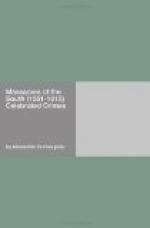Meanwhile the Rhone, refusing to be an accomplice in such a crime, bore away the corpse, which the assassins believed had been swallowed up for ever. Next day it was found on the sandy shore at Tarascon, but the news of the murder had preceded it, and it was recognised by the wounds, and pushed back again into the waters, which bore it towards the sea.
Three leagues farther on it stopped again, this time by a grassy bank, and was found by a man of forty and another of eighteen. They also recognised it, but instead of shoving it back into the current, they drew it up gently on the bank and carried it to a small property belonging to one of them, where they reverently interred it. The elder of the two was M. de Chartruse, the younger M. Amedee Pichot.
The body was exhumed by order of the marshal’s widow, and brought to her castle of Saint-Just, in Champagne; she had it embalmed, and placed in a bedroom adjoining her own, where it remained, covered only by a veil, until the memory of the deceased was cleansed from the accusation of suicide by a solemn public trial and judgment. Then only it was finally interred, along with the parchment containing the decision of the Court of Riom.
The ruffians who killed Marshal Brune, although they evaded the justice of men, did not escape the vengeance of God: nearly every one of them came to a miserable end. Roquefort and Farges were attacked by strange and hitherto unknown diseases, recalling the plagues sent by God on the peoples whom He desired to punish in bygone ages. In the case of Farges, his skin dried up and became horny, causing him such intense irritation, that as the only means of allaying it he had to be kept buried up to the neck while still alive. The disease under which Roquefort suffered seemed to have its seat in the marrow, for his bones by degrees lost all solidity and power of resistance, so that his limbs refused to bear his weight, and he went about the streets crawling like a serpent. Both died in such dreadful torture that they regretted having escaped the scaffold, which would have spared them such prolonged agony.
Pointu was condemned to death, in his absence, at the Assizes Court of La Drome, for having murdered five people, and was cast off by his own faction. For some time his wife, who was infirm and deformed, might be seen going from house to house asking alms for him, who had been for two months the arbiter of civil war and assassination. Then came a day when she ceased her quest, and was seen sitting, her head covered by a black rag: Pointu was dead, but it was never known where or how. In some corner, probably, in the crevice of a rock or in the heart of the forest, like an old tiger whose talons have been clipped and his teeth drawn.




